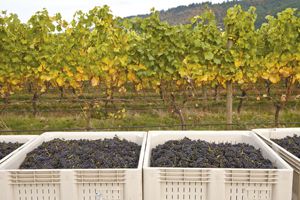Acid Quest

By Jessica Cortell
Acid. Too much and a wine can taste sharp, too little and it is flat. Acidity plays important roles in wine preservation and taste perception. Wines grown in cool climates are often known to be “bright” with acidity compared to wines from hot climates. The acid in wine helps define the style of a region. The Willamette Valley is a cool grape-growing region, and the last two seasons have been unusually cool creating the potential for wines with higher than average acidity.
Two major acids found in grapes are tartaric acid and malic acid. These are distinctly different in how they are biosynthesized in the grape, where they are stored, how the levels change as the grapes ripe and how they are perceived in wine. Potassium and pH are also intertwined with titratable acidity, but the relationships are not as similar and straightforward as people often expect. Generally. wines are preferred with acidity in the range of 5.5 to 8.5 g/L with whites at the higher end. The desired pH is between 3.1 and 5.6.
Tartaric acid develops primarily in the skin with lower levels in the pulp. It is at a maximum at the start of veraison. During ripening (post-veraison), the concentration decreases due to berry enlargement resulting in dilution of the acidity. Additionally, the tartaric acid is in the free-acid form and during berry maturation, progressively, more tartaric acid combines with ions such as potassium.
Malic acid — think Granny Smith apple — increases up to veraison and then decreases during ripening. It is found primarily in the pulp with low levels in the grape skins. While malic acid concentrations also decrease due to dilution, the grapes will also catabolize, or break down, malic acid and use it for other purposes.
In hot climates, the grapes will often metabolize all the malic acid prior to harvest. In contrast, in a cool climate, the fruit may retain most of its malic acid at harvest. The catabolism of malic acid is closely correlated with berry temperatures and proceeds at higher rates at higher temperatures.
In the cool 2010 vintage, acid levels were high in many bins of fruit; however, a higher than normal proportion was malic acid. Luckily, there is a secondary fermentation (MLF) process done by malolactic bacteria in the winery that converts malic acid to lactic acid.
The impact of MLF will depend on the ratio of tartaric to malic acid in the fruit. MLF results in lower acidity, a rise in the pH and a softening of the wine sensory characteristics. This conversion is typically carried out in red wines and in some whites, depending on the style of the wine being made. Oregon is developing a good reputation with Chardonnay by retaining the natural acidity.
Initially, winemakers were concerned about the high levels of acidity in Pinot Noir, but then the worry changed to where we will be after completion of MLF? Will our acids be to low and pH too high? Some winemakers opted to add tartaric acid up front to the fermenters to hopefully end up in the right place after MLF. How ironic, since you wouldn’t typically think of adding acid in one of the coolest vintages on record…
Others proceeded without acid additions. Don Sandberg of Iota Cellars started out with high titratable acidity but noting most of it was malic acid, he preceded with MLF. “The conversion was huge,” he said. He was happy with the resulting balance in the wines after the completion of MLF.
Surprisingly, the environmental impacts on biosynthesis of tartaric and malic acid in grapes prior to veraison are not well understood. As far as viticultural practices, basal leaf removal generally reduces titratable acidity by increasing berry temperature. Leaf removal can reduce potassium uptake into the fruit and enhance malic acid degradation. Tartaric acid levels are rarely influenced by leaf removal.
Regarding pH, as the fruit ripens, the pH goes up, both in response to the decline in acidity and the increase in potassium uptake into the fruit. In the later stages of ripening, the rise in pH is primarily due to an influx of potassium.
In late vintages such as 2010, where basal leaves start yellowing, potassium can be remobilized from the leaves and move into the fruit and trunk. Consequently, while one would anticipate a low pH and high acidity in a cool vintage, this isn’t always true. Some fruit had a high pH related to potassium uptake and high acidity in 2010. For winemakers, this is a more difficult situation to manage in the winery. While high potassium in the fruit is undesirable for a winemaker, there is a high correlation between potassium and sugar accumulation in the fruit, so potassium deficiencies can impact the rate of fruit ripening.
With another cool vintage upon us, winemakers will be facing a new set of variables and need to be on their toes in making the best decisions to find balance in the 2011 vintage. However, winemaking wouldn’t be so fascinating if we could simply follow a recipe book.








